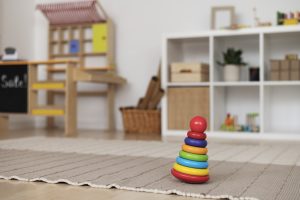The Legacy of Dr. Maria Montessori
Dr. Maria Montessori was a revolutionary educator and pioneer in child development research. She was the first female physician in Italy at her university and began her career working alongside curative pedagogists—experts in therapeutic education for children with learning difficulties. Initially, she focused on special needs education, later extending her scientifically-backed Montessori teaching methods to all children, regardless of ability. Montessori was also a mathematician, scientist, and keen observer of early childhood learning patterns. Her method was not simply created—it was discovered through years of research, child psychology studies, and hands-on classroom practice.
👉 Learn more about Maria Montessori’s biography and her impact on early education methods.

What is the Montessori Method?
At its core, the Montessori education system is a child-centered approach that emphasizes learning through hands-on experiences, multi-sensory engagement, and self-directed activities. Dr. Montessori believed that children between the ages of 0 to 6 years absorb information effortlessly from their environment—much like a sponge. This is known as the “absorbent mind” phase in early childhood education.
Think about this: Did anyone teach you your mother tongue through structured lessons? Likely not—you absorbed it by listening, observing, and repeating. In the same way, Montessori children develop literacy, numeracy, and life skills through tactile learning, sensory play, and interactive engagement rather than passive memorization.
The Four Pillars of Montessori Education (0–6 Years)
Montessori early childhood education focuses on four key areas of development, all of which support a child’s physical, emotional, social, and cognitive growth.
1. Practical Life Activities (EPL) – Developing Independence and Motor Skills
These are real-life tasks that children see at home, such as pouring, cleaning, folding clothes, and buttoning shirts. In a Montessori setting, these tasks have a deeper educational purpose:
- Building independence and self-care skills
- Enhancing fine motor skills and hand-eye coordination
- Developing focus, order, and concentration
- Instilling a sense of responsibility and self-discipline
✨ “Help me do it myself.” — The essence of Montessori Practical Life activities.
2. Sensorial Activities – Refining Perception and Cognitive Growth
This area helps children refine their five senses—touch, sight, smell, hearing, and taste—by engaging with specially designed Montessori materials. Sensorial education supports:
- Recognition of patterns, colors, textures, and shapes
- Differentiation of sizes, weights, temperatures, and sounds
- Pre-academic skills development for reading, writing, and mathematics
Sensorial materials lay the foundation for STEM-based learning, critical thinking, and problem-solving by sharpening a child’s ability to compare, classify, and make decisions.
3. Mathematics – Hands-On Approach to Building Strong Foundations
In traditional education, math is often taught through rote memorization. However, Montessori math follows a concrete-to-abstract learning approach, where children first experience mathematical concepts physically before moving to written numbers and operations.
- Golden Beads for understanding place value (units, tens, hundreds, thousands)
- Number rods and spindle boxes for counting practice
- Movable numerals for hands-on arithmetic
- Multiplication and division boards for experiential learning
👉 Explore Montessori math tools: A beginner’s guide to Montessori Math Materials for early numeracy skills.
4. Language – A Phonetic Approach to Early Literacy
Montessori introduces phonetic sounds before alphabet names, making reading and writing more intuitive. This method:
- Encourages early literacy through phonemic awareness
- Uses tactile materials like sandpaper letters and the moveable alphabet
- Promotes natural reading and spelling skills through real-world experiences
Children learn to read and write in the same way they learn to speak—by engaging with words in meaningful contexts, rather than through isolated drills.
Why Start with Practical Life and Sensorial Activities?
Dr. Montessori emphasized Practical Life (EPL) activities as the foundation for all learning because children naturally enjoy participating in everyday tasks they see adults doing. This creates:
- Confidence and self-reliance
- A sense of responsibility and teamwork
- Readiness for more advanced academic concepts
On the other hand, Sensorial education helps prepare children for literacy, numeracy, and critical thinking by sharpening their perception and cognitive skills. Montessori Sensorial exercises are a stepping stone for future STEM education, logical reasoning, and executive function development.
Montessori is Scientific, Systematic, and Child-Led
Montessori is not just an educational method—it is a philosophy based on child psychology, scientific research, and individualized learning pathways. It is:
- Scientific – Based on over a century of child development research
- Systematic – Uses structured materials and progressive learning techniques
- Individualized – Follows the unique pace and interests of each child
🧠 “Follow the child, but be prepared to lead when needed.” — Maria Montessori
The Ultimate Goal: Independence and Responsibility
Montessori classrooms provide freedom within limits, allowing children to:
- Make choices and solve problems independently
- Manage time and responsibilities effectively
- Respect others, their environment, and the learning process
This approach fosters self-discipline, accountability, and a lifelong love for learning, shaping children into confident, capable individuals.
Final Thoughts: Why Montessori is More Than Just a Teaching Method
Montessori is not just about academics—it’s a way of life. It respects the child as a whole person, capable of self-growth, curiosity-driven exploration, and mastery of skills at their own pace. In today’s fast-paced world, Montessori education stands as a reminder that childhood is a time for discovery, creativity, and independent thinking.
“Let me learn at my pace. Let me explore. Let me be me.”
Leave a Reply